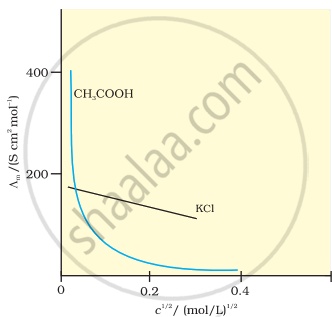Advertisements
Advertisements
प्रश्न
Discuss the variation of conductivity and molar conductivity with concentration.
उत्तर
Both conductivity and molar conductivity change with the change in concentration of electrolyte. Conductivity always decreases with decreasing the concentration of both weak and strong electrolytes. This can be explained by the fact that with dilution, the number of ions carrying electric current per unit volume decreases. The conductivity of a solution at any concentration is the conductivity of a unit volume of the solution placed between two platinum electrodes having a unit cross-sectional area and situated at unit distance from each other.
This is clear from the following equation:
C = `"κA"/"l"` = κ ...(Both A and I are in appropriate units m or cm)
The molar conductivity of a solution at a given concentration is the conductivity of volume V of the solution containing one mole of electrolyte dissolved in it and placed between two electrodes of cross-sectional area A, located at a unit distance from each other. So,

Plot of c1/2 versus molar conductivity for potassium chloride (a strong electrolyte) in aqueous solution.
∧m = `"κA"/"l"` = κ
Since l = 1 and A = V (volume in which one mole of electrolyte is dissolved.)
∧m = κ V
Molar conductivity increases with decreasing concentration. This is because the total volume (V) in which one mole of electrolyte is present also increases. It has been found that on dilution of the solution, the increase in volume is much more than the decrease in κ.
Strong Electrolytes: For strong electrolytes, the value of Δm increases gradually with dilution and it can be represented by the following equation:
∧m = `∧_"m"^0 - "Ac"^(1//2)`
It can be seen that if ∧m is plotted against c1/2, we get a straight line with intercept A and slope equal to ‘A’. The value of constant ‘A’ at a given solvent and temperature depends on the type of electrolyte, i.e., on the charges of the cation and anion produced on dissociation of the electrolyte in solution. Thus, \[\ce{NaCl, CaCl2, MgSO4}\] are known as 1-1, 2-1 and 2-2 electrolytes, respectively. The value of ‘A’ is the same for all electrolytes of the same type.
संबंधित प्रश्न
The molar conductivity of cation and anion of salt BA are 180 and 220 mhos respectively. The molar conductivity of salt BA at infinite dilution is_____________ .
(a) 90 mhos.cm2
(b) 110 mhos.cm2.mol-1
(c) 200 mhos.cm2.mol-1
(d) 400 mhos.cm2.mol-1
The conductivity of 0.20 M solution of KCl at 298 K is 0.025 S cm−1. Calculate its molar conductivity.
Why conductivity of an electrolyte solution decreases with the decrease in concentration ?
How can you determine limiting molar conductivity, 0 m for strong electrolyte and weak electrolyte?
Assertion: `"E"_("Ag"^+ //"Ag")` increases with increase in concentration of Ag+ ions.
Reason: `"E"_("Ag"^+ //"Ag")` has a positive value.
Assertion: Copper sulphate can be stored in zinc vessel.
Reason: Zinc is less reactive than copper.
Solutions of two electrolytes ‘A’ and ‘B’ are diluted. The Λm of ‘B’ increases 1.5 times while that of A increases 25 times. Which of the two is a strong electrolyte? Justify your answer. Graphically show the behavior of ‘A’ and ‘B’.
Which of the following halogen acids is the strongest reducing agent?
The molar conductivity of 0.007 M acetic acid is 20 S cm2 mol−1. What is the dissociation constant of acetic acid? Choose the correct option.
`[(Λ_("H"^+)^ο = 350 "S" "cm"^2 "mol"^-1), (Λ_("CH"_3"COO"^-)^ο = 50 "S" "cm"^2 "mol"^-1)]`
Molar conductivity of substance “A” is 5.9 × 103 S/m and “B” is 1 × 10–16 S/m. Which of the two is most likely to be copper metal and why?
